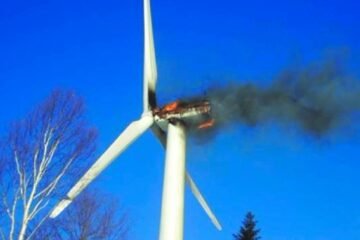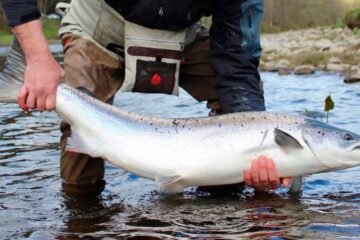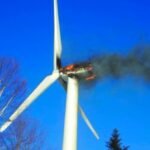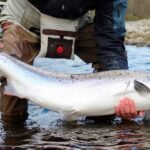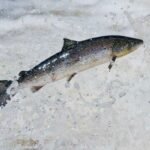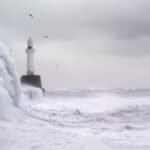Scotland recorded its hottest day of the year so far on Thursday, with the mercury soaring to 22.7°C in Aboyne, Aberdeenshire, as emergency services scrambled to contain multiple wildfires erupting across the country.
The unseasonably warm and dry conditions, intensified by climate-driven weather patterns, have forced the Scottish Fire and Rescue Service (SFRS) to upgrade their wildfire risk from “very high” to “extreme” across central, eastern, northern, and southwestern regions of the country.
Four Major Fires Erupt in One Day
As temperatures rose, fires broke out in Glen Rosa on the Isle of Arran, near John Kennedy Drive in Thurso, in Cumbernauld, and across the Pentland Hills near Edinburgh—all within the space of a few hours.
Residents were urged to shut windows and avoid travel near affected areas, while firefighting crews faced the prospect of working through the night to contain blazes driven by wind and parched terrain.
At Glen Rosa, smoke and flames were visible across the valley, with one resident describing the hillsides as “blackened and burning fiercely.” The blaze started at around 1:00 PM and was still smouldering by evening despite the deployment of multiple engines and crews. Locals reported ash falling from the sky.
“It seems to be moving further west, so it still seems to be burning quite fiercely,” said Gavin Mutch of the Cladach Sawmill and Garden Centre, who could see the fire from his workplace.
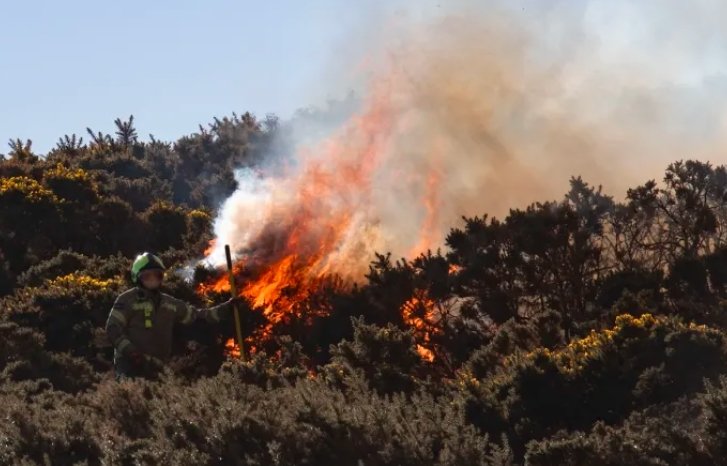
“Extreme” Fire Risk After Weeks of Sunshine and Dry Air
The wildfires have come after a prolonged dry spell across much of Scotland. March delivered just 64% of average rainfall, and the first half of April has followed suit.
According to meteorologists, the current conditions are linked to an Omega blocking pattern—a high-pressure system trapped over the UK due to a northward-shifted jet stream, which has effectively kept out cloud and rain.
This setup has created a rare mix: hot days, frosty nights, and tinderbox vegetation.
“We’re dealing with extremely dry ground conditions and dead vegetation,” said Deputy Assistant Chief Officer Kenny Barbour of the SFRS. “Fires can ignite easily and spread quickly over large areas.”
The upgraded “extreme” warning for wildfires covers Dumfries and Galloway, the Central Belt, Highland areas, and much of the northeast. Firefighters are asking the public to refrain from lighting barbecues, discarding cigarettes, or starting open fires, even in remote areas.
A Tale of Two Temperatures: -3.2°C to 22.7°C in One Day
While the mid-day heat dominated headlines, the day began with frost. Aboyne, which later topped the charts with 22.7°C, also recorded Scotland’s coldest overnight temperature of the year at -3.2°C—a staggering swing of nearly 26 degrees Celsius in less than 12 hours.
This duality is not unusual in early spring, but the speed and scale of warming are part of a longer-term trend.
According to recent climate data, spring is now the fastest-warming season in the UK, with average temperatures rising by 1.8°C since 1970.
Local Families Embrace the Heat—Cautiously
Despite the fire risk, many Scots took full advantage of the summer-like weather before the weekend’s expected return of damper conditions.
In Aboyne, Laura Booth and Ailsa McHardy were out in the park with their babies, George and Skye, enjoying a picnic on what turned out to be a record-setting afternoon.
“I wasn’t expecting it to be this warm,” said Laura. “It makes such a difference to be outside.”
“It’s really good—hopefully more sunny days to come,” added Ailsa.
Yet even among the sunshine, there was a sense of unease.
“Every year it seems to get warmer earlier,” said one local, glancing nervously toward the haze rising on the horizon. “It’s lovely, but it doesn’t feel quite right.”
Emergency Response Stretched
Fire services across Scotland remain on high alert. In Cumbernauld, eight fire engines were dispatched to a new blaze near Fannyside Loch just before 11:00 PM on Thursday.
Meanwhile, four engines were called to gorse fires in the Pentlands near Edinburgh, with reports of intense flames and thick smoke spreading along walking trails.
A major blaze earlier in the week in Dumfries and Galloway forced the evacuation of campers and burned for several days before being brought under control.
“Wildfires have the potential to burn for days,” said Barbour. “They’re devastating to the environment, dangerous to the public, and incredibly resource-intensive.”
Relief on the Way?
Forecasters say cooler, wetter weather is likely to return by the weekend, thanks to a shift in atmospheric pressure expected to push the jet stream southward.
But after two weeks of near-unbroken sunshine, the risk doesn’t vanish overnight.
“We may get a break in the weather, but the ground remains dry, and vegetation doesn’t recover that quickly,” warned SFRS officials.
A Warning and a Wake-Up Call
The scenes unfolding across Scotland this week are dramatic, but not unexpected. Climate scientists have been sounding the alarm about the increasing frequency and severity of wildfires in regions previously considered too damp or cool for such events.
“We’re entering a new climate reality,” said Dr. Fiona McIntosh, a climate researcher at the University of Edinburgh. “We need better fire preparedness, public education, and long-term adaptation strategies.”
From picnics under clear blue skies to flames licking the edges of national parks, Scotland is facing a paradox of beauty and danger—one that may become all too common in the years ahead.


